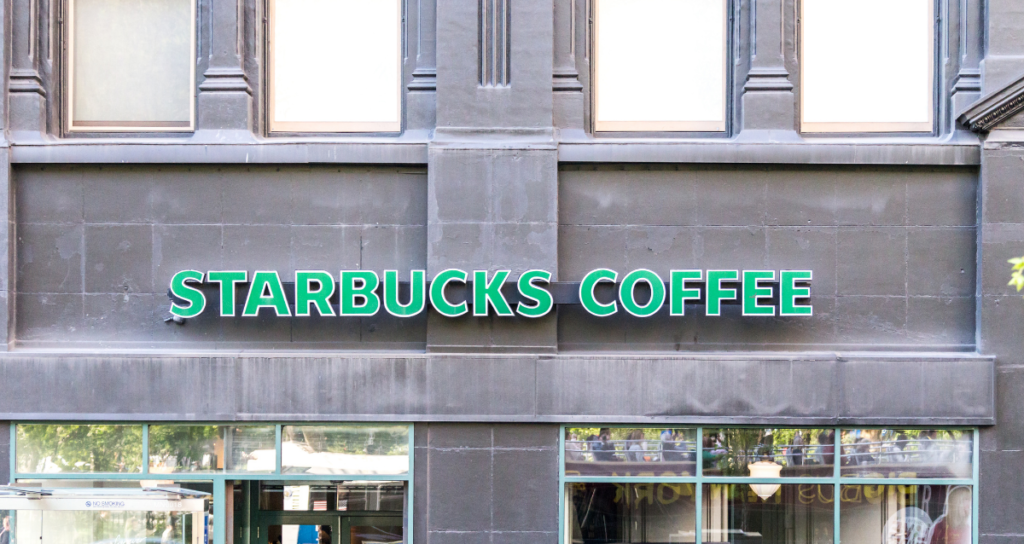Starbucks transcends the conventional coffee shop; it often becomes a defining emblem of one’s identity. With every sip of its invigorating and confidence-boosting concoctions, Starbucks skillfully cultivates an exclusive atmosphere. But how does Starbucks curate this sentiment, and how has it achieved the staggering feat of establishing an expansive network of 30,000 stores across the globe? In this article, we’ll delve into the business and marketing insights that have fueled Starbucks’ remarkable growth.

The Power of Branding
While Starbucks might not hold the title of the world’s finest chain coffee brand, it undoubtedly claims the title of the most renowned. Over the years, Starbucks has invested significantly in its branding efforts, propelling the green mermaid to international recognition. The foundation of Starbucks’ success lies in building recognizable brand visibility. Its iconic green logo is instantly distinguishable even from a distance. To optimize brand exposure, Starbucks strategically places its logo on cup sleeves at the opposite end of the drinking spout, ensuring the logo is always outward-facing.
This meticulous attention to detail ensures that every customer becomes a brand ambassador. The rapid proliferation of Starbucks outlets, each serving their distinct drinks in cups adorned with the green emblem, incites a sense of anticipation and allure among the masses, attracting an ever-growing clientele. Starbucks has successfully made its logo a symbol of quality and consistency.
Cultivating a Lifestyle Brand
In its early iterations, Starbucks often depicted a figure donned in formal attire, holding a Starbucks coffee, subtly suggesting that those who indulge in Starbucks beverages hold a higher social status. Gradually, this notion morphed into a collective belief. Starbucks has masterfully positioned itself as more than just a coffee provider; it’s a lifestyle brand.
Starbucks doesn’t merely sell coffee; it sells an experience, a sense of belonging, and a statement of identity. This is evident in the way Starbucks stores are designed – cozy seating areas, soothing music, and an ambience that encourages customers to linger and make Starbucks a part of their daily routine.

Global Consistency with Local Flavor
In its pursuit of consistent flavour across the globe, Starbucks chose to utilize dark roast coffee beans over more fragrant light roast variants. The inherent 12-month shelf life of dark roast beans proves ideal for supplying the multitude of Starbucks locations around the world while maintaining consistent taste profiles.
However, Starbucks also understands the importance of adapting to local cultures. In various countries, Starbucks crafts tailor-made products and adorns its stores in a manner resonant with local aesthetics. This approach provides customers with an authentically distinct shopping experience at Starbucks outlets worldwide. It’s a delicate balance between global consistency and local relevance, a strategy that has resonated with consumers globally.

Loyalty Programs and Customer Retention
Starbucks’ membership program continuously entices repeat purchases by offering increasingly attractive rewards across its tiers. This strategic reward system effectively reinforces customers’ affinity for Starbucks, driving them to frequent the brand. Starbucks understands that customer retention is as important as acquisition, and its loyalty program is a testament to this understanding.
Moreover, Starbucks leverages data analytics to personalize offers and recommendations for its customers. This data-driven approach not only enhances customer satisfaction but also drives sales by suggesting products that align with individual preferences.
Learning from Past Ventures
At one point, Starbucks’ stock price experienced a significant drop from $37 to $7.83, a consequence of the company’s endeavor to enter the entertainment industry. This venture encompassed ventures like a music recording label, cinematic releases, and the establishment of an “entertainment” office.
While this venture didn’t yield the expected results, it taught Starbucks valuable lessons about staying true to its core business. Starbucks realized that its strength lay in coffee and the unique experience it provided, not in the entertainment sector. This pivot back to its core competencies allowed Starbucks to refocus its efforts on delivering exceptional coffee and customer experiences, which ultimately contributed to its resurgence.
Final words
Starbucks’ journey from a single coffee shop to a global phenomenon offers invaluable business and marketing insights. The company’s commitment to brand visibility, lifestyle branding, global consistency with local adaptation, customer retention strategies, and the ability to learn from past ventures have all played pivotal roles in its remarkable growth. As Starbucks continues to evolve and expand, it serves as a case study for businesses aiming to create enduring brands and captivate customers worldwide.



